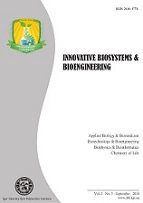Production of Yeast-Based Products: Multi-Purpose Use of Traditional Fermentation
DOI:
https://doi.org/10.20535/ibb.2025.9.3.333652Keywords:
yeast, biomass, Saccharomyces cerevisiae, fed-batch fermentation, yeast-based productAbstract
Background. Traditional industrial production of Saccharomyces cerevisiae primarily yields pressed baker's yeast through multi-stage fed-batch fermentation. However, there is increasing demand for diverse yeast-based products with tailored functional properties, requiring a more flexible production approach than the conventional single-product focus.
Objective. This study aimed to develop and propose a flexible fermentation scheme for an industrial S. cerevisiae strain to enable the production of a variety of yeast products from a single line by optimizing fermentation parameters to achieve desired biomass characteristics.
Methods. Using the industrial strain S. cerevisiae in fed-batch bioreactors, key fermentation parameters – including temperature, pH, and carbon/nitrogen dosing profiles – were systematically varied. The resulting yeast biomass was analyzed for composition (protein, trehalose, glycogen, RNA) and functional properties (rising power, ethanol tolerance) to assess the impact of the parameter modifications.
Results. Modifying fermentation parameters significantly influenced yeast biomass composition and functional traits. Specific fermentation profiles were successfully developed to produce biomass suitable for various products, including different forms of baker's yeast, yeast for alcohol/wine/beer production, protein source yeast, and yeast for extracts. Targeted control of parameters allowed for the accumulation of specific components essential for each application.
Conclusions. Optimizing S. cerevisiae fermentation parameters is product-specific and allows for the production of a diverse range of yeast-based products from a single industrial line. Controlling nutrient dosing, temperature, pH, and ethanol concentration enables tailoring biomass composition and characteristics, representing a significant advancement towards a versatile multi-product fermentation model.
References
Reed G, Nagodawithana TW. Yeast Technology. Dordrecht: Springer Netherlands; 1991, 454 p. DOI: 10.1007/978-94-011-9771-7
White J, Munns DJ. Nutrilites and the production of pressed yeast. Journal of the Institute of Brewing. 1950;56(3):194-202. DOI: 10.1002/j.2050-0416.1950.tb01532.x
Mustafa G, Arshad M, Bano I, Abbas M. Biotechnological applications of sugarcane bagasse and sugar beet molasses. Biomass Conversion and Biorefinery. 2023;13(2):1489-501. DOI: 10.1007/s13399-020-01141-x
Lisičar J, Scheper T, Barbe S. Turning Industrial Baker's Yeast Manufacture into a Powerful Zero Discharge Multipurpose Bioprocess. Industrial Biotechnology. 2017;13(4):184-91. DOI: 10.1089/ind.2017.0018
Freund O. Bakers' and Nutritional Yeast Production. Proceedings. Annual meeting - American Society of Brewing Chemists. 1964;22(1):70-3. DOI: 10.1080/00960845.1964.12006740
Nya E, Etukudo O. Industrial Potentials of Saccharomyces cerevisiae. British Journal of Multidisciplinary and Advanced Studies. 2023;4(2):23-46. DOI: 10.37745/bjmas.2022.0152
Wang Z, Qi X, Ren X, Lin Y, Zeng F, Wang Q. Synthetic evolution of Saccharomyces cerevisiae for biomanufacturing: Approaches and applications. mLife. 2025;4(1):1-16. DOI: 10.1002/mlf2.12167
Yook S, Alper HS. Recent advances in genetic engineering and chemical production in yeast species. FEMS Yeast Research. 2025;25:foaf009. DOI: 10.1093/femsyr/foaf009
Ma J, Sun Y, Meng D, Zhou Z, Zhang Y, Yang R. Yeast proteins: The novel and sustainable alternative protein in food applications. Trends in Food Science & Technology. 2023;135:190-201. DOI: 10.1016/j.tifs.2023.04.003
Sirisena S, Chan S, Roberts N, Dal Maso S, Gras SL, Martin GJO. Influence of yeast growth conditions and proteolytic enzymes on the amino acid profiles of yeast hydrolysates: Implications for taste and nutrition. Food Chemistry. 2024;437(Part 2):137906. DOI: 10.1016/j.foodchem.2023.137906
Zhou P, Liu Q, Zhao Y, Wu Y, Shen J, Duan T, et al. Yeast protein as a fishmeal substitute: impacts on reproductive performance, immune responses, and gut microbiota in two sow hybrids. Frontiers in Cellular and Infection Microbiology. 2025;15:1579950. DOI: 10.3389/fcimb.2025.1579950
Lynch JM, Barbano DM. Kjeldahl Nitrogen Analysis as a Reference Method for Protein Determination in Dairy Products. Journal of AOAC International. 1999;82(6):1389-98. DOI: 10.1093/jaoac/82.6.1389
Yemm EW, Willis AJ. The estimation of carbohydrates in plant extracts by anthrone. Biochemical Journal. 1954;57(3):508-14. DOI: 10.1042/bj0570508
International Oenological Codex, 2024. Oiv.int. Available from: https://www.oiv.int/sites/default/files/publication/2024-03/CODEX%20oenologique%20EN%202024.pdf.
Sriariyanun M, Mutrakulcharoen P, Tepaamorndech S, Cheenkachorn K, Rattanaporn K. A Rapid Spectrophotometric Method for Quantitative Determination of Ethanol in Fermentation Products. Oriental Journal of Chemistry. 2019;35(2):744-50. DOI: 10.13005/ojc/350234
Bakare V, Abdulsalami MS, Onusiriuka BC, Appah J, Benjamin B, Ndibe TO. Ethanol production from lignocellulosic materials by fermentation process using yeast. Journal of Applied Sciences and Environmental Management. 2019;23(5):875-82. DOI: 10.4314/jasem.v23i5.17
VH Berlin Standard Operating Procedure SOP H 04 dough raising Comparison of VH Berlin standard equipment with the ANKOMRF Gas Production System. Ankom.com. Available from: https://www.ankom.com/sites/default/files/document-files/VH-Berlin_Dough_Rising_Comparative.pdf.
Halász A, Lásztity R. Use of Yeast Biomass in Food Production, 1st ed. Boca Raton: CRC Press; 2017, 352 p. DOI: 10.1201/9780203734551
Vieira ÉD, Andrietta MGS, Andrietta SR. Yeast biomass production: a new approach in glucose-limited feeding strategy. Brazilian Journal of Microbiology. 2013;44(2):551-8. DOI: 10.1590/s1517-83822013000200035
Zakhartsev M, Yang X, Reuss M, Pörtner HO. Metabolic efficiency in yeast Saccharomyces cerevisiae in relation to temperature dependent growth and biomass yield. Journal of Thermal Biology. 2015;52:117-29. DOI: 10.1016/j.jtherbio.2015.05.008
Downloads
Published
How to Cite
Issue
Section
License
Copyright (c) 2025 The Author(s)

This work is licensed under a Creative Commons Attribution 4.0 International License.
The ownership of copyright remains with the Authors.
Authors may use their own material in other publications provided that the Journal is acknowledged as the original place of publication and National Technical University of Ukraine “Igor Sikorsky Kyiv Polytechnic Institute” as the Publisher.
Authors are reminded that it is their responsibility to comply with copyright laws. It is essential to ensure that no part of the text or illustrations have appeared or are due to appear in other publications, without prior permission from the copyright holder.
IBB articles are published under Creative Commons licence:- Authors retain copyright and grant the journal right of first publication with the work simultaneously licensed under CC BY 4.0 that allows others to share the work with an acknowledgement of the work's authorship and initial publication in this journal.
- Authors are able to enter into separate, additional contractual arrangements for the non-exclusive distribution of the journal's published version of the work (e.g., post it to an institutional repository or publish it in a book), with an acknowledgement of its initial publication in this journal.
- Authors are permitted and encouraged to post their work online (e.g., in institutional repositories or on their website) prior to and during the submission process, as it can lead to productive exchanges, as well as earlier and greater citation of published work.









